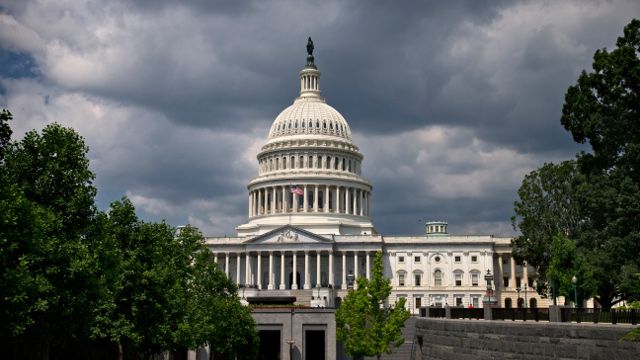Essay: Anatomy of the Deep State

Rome lived upon its principal till ruin stared it in the face. Industry is the only true source of wealth, and there was no industry in Rome. By day the Ostia road was crowded with carts and muleteers, carrying to the great city the silks and spices of the East, the marble of Asia Minor, the timber of the Atlas, the grain of Africa and Egypt; and the carts brought out nothing but loads of dung. That was their return cargo.
— The Martyrdom of Man by Winwood Reade (1871)
There is the visible government situated around the Mall in Washington, and then there is another, more shadowy, more indefinable government that is not explained in Civics 101 or observable to tourists at the White House or the Capitol. The former is traditional Washington partisan politics: the tip of the iceberg that a public watching C-SPAN sees daily and which is theoretically controllable via elections. The subsurface part of the iceberg I shall call the Deep State, which operates according to its own compass heading regardless of who is formally in power. [1]
During the last five years, the news media have been flooded with pundits decrying the broken politics of Washington. The conventional wisdom has it that partisan gridlock and dysfunction have become the new normal. That is certainly the case, and I have been among the harshest critics of this development. But it is also imperative to acknowledge the limits of this critique as it applies to the American governmental system. On one level, the critique is self-evident: In the domain that the public can see, Congress is hopelessly deadlocked in the worst manner since the 1850s, the violently rancorous decade preceding the Civil War.
Despite this apparent impotence, President Obama can liquidate American citizens without due processes, detain prisoners indefinitely without charge, conduct dragnet surveillance on the American people without judicial warrant and engage in unprecedented — at least since the McCarthy era — witch hunts against federal employees (the so-called “Insider Threat Program”). Within the United States, this power is characterized by massive displays of intimidating force by militarized federal, state and local law enforcement. Abroad, President Obama can start wars at will and engage in virtually any other activity whatsoever without so much as a by-your-leave from Congress, such as arranging the forced landing of a plane carrying a sovereign head of state over foreign territory. Despite the habitual cant of congressional Republicans about executive overreach by Obama, the would-be dictator, we have until recently heard very little from them about these actions — with the minor exception of comments from gadfly Senator Rand Paul of Kentucky. Democrats, save a few mavericks such as Ron Wyden of Oregon, are not unduly troubled, either — even to the extent of permitting seemingly perjured congressional testimony under oath by executive branch officials on the subject of illegal surveillance.
These are not isolated instances of a contradiction; they have been so pervasive that they tend to be disregarded as background noise. During the time in 2011 when political warfare over the debt ceiling was beginning to paralyze the business of governance in Washington, the United States government somehow summoned the resources to overthrow Muammar Ghaddafi’s regime in Libya, and, when the instability created by that coup spilled over into Mali, provide overt and covert assistance to French intervention there. At a time when there was heated debate about continuing meat inspections and civilian air traffic control because of the budget crisis, our government was somehow able to commit $115 million to keeping a civil war going in Syria and to pay at least £100m to the United Kingdom’s Government Communications Headquarters to buy influence over and access to that country’s intelligence. Since 2007, two bridges carrying interstate highways have collapsed due to inadequate maintenance of infrastructure, one killing 13 people. During that same period of time, the government spent $1.7 billion constructing a building in Utah that is the size of 17 football fields. This mammoth structure is intended to allow the National Security Agency to store a yottabyte of information, the largest numerical designator computer scientists have coined. A yottabyte is equal to 500 quintillion pages of text. They need that much storage to archive every single trace of your electronic life.
Yes, there is another government concealed behind the one that is visible at either end of Pennsylvania Avenue, a hybrid entity of public and private institutions ruling the country according to consistent patterns in season and out, connected to, but only intermittently controlled by, the visible state whose leaders we choose. My analysis of this phenomenon is not an exposé of a secret, conspiratorial cabal; the state within a state is hiding mostly in plain sight, and its operators mainly act in the light of day. Nor can this other government be accurately termed an “establishment.” All complex societies have an establishment, a social network committed to its own enrichment and perpetuation. In terms of its scope, financial resources and sheer global reach, the American hybrid state, the Deep State, is in a class by itself. That said, it is neither omniscient nor invincible. The institution is not so much sinister (although it has highly sinister aspects) as it is relentlessly well entrenched. Far from being invincible, its failures, such as those in Iraq, Afghanistan and Libya, are routine enough that it is only the Deep State’s protectiveness towards its higher-ranking personnel that allows them to escape the consequences of their frequent ineptitude. [2]
How did I come to write an analysis of the Deep State, and why am I equipped to write it? As a congressional staff member for 28 years specializing in national security and possessing a top secret security clearance, I was at least on the fringes of the world I am describing, if neither totally in it by virtue of full membership nor of it by psychological disposition. But, like virtually every employed person, I became, to some extent, assimilated into the culture of the institution I worked for, and only by slow degrees, starting before the invasion of Iraq, did I begin fundamentally to question the reasons of state that motivate the people who are, to quote George W. Bush, “the deciders.”

A more elusive aspect of cultural assimilation is the sheer dead weight of the ordinariness of it all once you have planted yourself in your office chair for the 10,000th time. Government life is typically not some vignette from an Allen Drury novel about intrigue under the Capitol dome. Sitting and staring at the clock on the off-white office wall when it’s 11:00 in the evening and you are vowing never, ever to eat another piece of takeout pizza in your life is not an experience that summons the higher literary instincts of a would-be memoirist. After a while, a functionary of the state begins to hear things that, in another context, would be quite remarkable, or at least noteworthy, and yet that simply bounce off one’s consciousness like pebbles off steel plate: “You mean the number of terrorist groups we are fighting is classified?” No wonder so few people are whistle-blowers, quite apart from the vicious retaliation whistle-blowing often provokes: Unless one is blessed with imagination and a fine sense of irony, growing immune to the curiousness of one’s surroundings is easy. To paraphrase the inimitable Donald Rumsfeld, I didn’t know all that I knew, at least until I had had a couple of years away from the government to reflect upon it.
The Deep State does not consist of the entire government. It is a hybrid of national security and law enforcement agencies: the Department of Defense, the Department of State, the Department of Homeland Security, the Central Intelligence Agency and the Justice Department. I also include the Department of the Treasury because of its jurisdiction over financial flows, its enforcement of international sanctions and its organic symbiosis with Wall Street. All these agencies are coordinated by the Executive Office of the President via the National Security Council. Certain key areas of the judiciary belong to the Deep State, such as the Foreign Intelligence Surveillance Court, whose actions are mysterious even to most members of Congress. Also included are a handful of vital federal trial courts, such as the Eastern District of Virginia and the Southern District of Manhattan, where sensitive proceedings in national security cases are conducted. The final government component (and possibly last in precedence among the formal branches of government established by the Constitution) is a kind of rump Congress consisting of the congressional leadership and some (but not all) of the members of the defense and intelligence committees. The rest of Congress, normally so fractious and partisan, is mostly only intermittently aware of the Deep State and when required usually submits to a few well-chosen words from the State’s emissaries.
I saw this submissiveness on many occasions. One memorable incident was passage of the Foreign Intelligence Surveillance Amendments Act of 2008. This legislation retroactively legalized the Bush administration’s illegal and unconstitutional surveillance first revealed by The New York Times in 2005 and indemnified the telecommunications companies for their cooperation in these acts. The bill passed easily: All that was required was the invocation of the word “terrorism” and most members of Congress responded like iron filings obeying a magnet. One who responded in that fashion was Senator Barack Obama, soon to be coronated as the presidential nominee at the Democratic National Convention in Denver. He had already won the most delegates by campaigning to the left of his main opponent, Hillary Clinton, on the excesses of the global war on terror and the erosion of constitutional liberties.
As the indemnification vote showed, the Deep State does not consist only of government agencies. What is euphemistically called “private enterprise” is an integral part of its operations. In a special series in The Washington Post called “Top Secret America,” Dana Priest and William K. Arkin described the scope of the privatized Deep State and the degree to which it has metastasized after the September 11 attacks. There are now 854,000 contract personnel with top-secret clearances — a number greater than that of top-secret-cleared civilian employees of the government. While they work throughout the country and the world, their heavy concentration in and around the Washington suburbs is unmistakable: Since 9/11, 33 facilities for top-secret intelligence have been built or are under construction. Combined, they occupy the floor space of almost three Pentagons — about 17 million square feet. Seventy percent of the intelligence community’s budget goes to paying contracts. And the membrane between government and industry is highly permeable: The Director of National Intelligence, James R. Clapper, is a former executive of Booz Allen Hamilton, one of the government’s largest intelligence contractors. His predecessor as director, Admiral Mike McConnell, is the current vice chairman of the same company; Booz Allen is 99 percent dependent on government business. These contractors now set the political and social tone of Washington, just as they are increasingly setting the direction of the country, but they are doing it quietly, their doings unrecorded in the Congressional Record or the Federal Register, and are rarely subject to congressional hearings.

The corridor between Manhattan and Washington is a well trodden highway for the personalities we have all gotten to know in the period since the massive deregulation of Wall Street: Robert Rubin, Lawrence Summers, Henry Paulson, Timothy Geithner and many others. Not all the traffic involves persons connected with the purely financial operations of the government: In 2013, General David Petraeus joined KKR (formerly Kohlberg Kravis Roberts) of 9 West 57th Street, New York, a private equity firm with $62.3 billion in assets. KKR specializes in management buyouts and leveraged finance. General Petraeus’ expertise in these areas is unclear. His ability to peddle influence, however, is a known and valued commodity. Unlike Cincinnatus, the military commanders of the Deep State do not take up the plow once they lay down the sword. Petraeus also obtained a sinecure as a non-resident senior fellow at the Belfer Center for Science and International Affairs at Harvard. The Ivy League is, of course, the preferred bleaching tub and charm school of the American oligarchy. [4]
Petraeus and most of the avatars of the Deep State — the White House advisers who urged Obama not to impose compensation limits on Wall Street CEOs, the contractor-connected think tank experts who besought us to “stay the course” in Iraq, the economic gurus who perpetually demonstrate that globalization and deregulation are a blessing that makes us all better off in the long run — are careful to pretend that they have no ideology. Their preferred pose is that of the politically neutral technocrat offering well considered advice based on profound expertise. That is nonsense. They are deeply dyed in the hue of the official ideology of the governing class, an ideology that is neither specifically Democrat nor Republican. Domestically, whatever they might privately believe about essentially diversionary social issues such as abortion or gay marriage, they almost invariably believe in the “Washington Consensus”: financialization, outsourcing, privatization, deregulation and the commodifying of labor. Internationally, they espouse 21st-century “American Exceptionalism”: the right and duty of the United States to meddle in every region of the world with coercive diplomacy and boots on the ground and to ignore painfully won international norms of civilized behavior. To paraphrase what Sir John Harrington said more than 400 years ago about treason, now that the ideology of the Deep State has prospered, none dare call it ideology. [5] That is why describing torture with the word “torture” on broadcast television is treated less as political heresy than as an inexcusable lapse of Washington etiquette: Like smoking a cigarette on camera, these days it is simply “not done.”

Still, despite the essential roles of lower Manhattan and Silicon Valley, the center of gravity of the Deep State is firmly situated in and around the Beltway. The Deep State’s physical expansion and consolidation around the Beltway would seem to make a mockery of the frequent pronouncement that governance in Washington is dysfunctional and broken. That the secret and unaccountable Deep State floats freely above the gridlock between both ends of Pennsylvania Avenue is the paradox of American government in the 21st century: drone strikes, data mining, secret prisons and Panopticon-like control on the one hand; and on the other, the ordinary, visible parliamentary institutions of self-government declining to the status of a banana republic amid the gradual collapse of public infrastructure.
The results of this contradiction are not abstract, as a tour of the rotting, decaying, bankrupt cities of the American Midwest will attest. It is not even confined to those parts of the country left behind by a Washington Consensus that decreed the financialization and deindustrialization of the economy in the interests of efficiency and shareholder value. This paradox is evident even within the Beltway itself, the richest metropolitan area in the nation. Although demographers and urban researchers invariably count Washington as a “world city,” that is not always evident to those who live there. Virtually every time there is a severe summer thunderstorm, tens — or even hundreds — of thousands of residents lose power, often for many days. There are occasional water restrictions over wide areas because water mains, poorly constructed and inadequately maintained, have burst. [6] The Washington metropolitan area considers it a Herculean task just to build a rail link to its international airport — with luck it may be completed by 2018.
It is as if Hadrian’s Wall was still fully manned and the fortifications along the border with Germania were never stronger, even as the city of Rome disintegrates from within and the life-sustaining aqueducts leading down from the hills begin to crumble. The governing classes of the Deep State may continue to deceive themselves with their dreams of Zeus-like omnipotence, but others do not. A 2013 Pew Poll that interviewed 38,000 people around the world found that in 23 of 39 countries surveyed, a plurality of respondents said they believed China already had or would in the future replace the United States as the world’s top economic power.
The Deep State is the big story of our time. It is the red thread that runs through the war on terrorism, the financialization and deindustrialization of the American economy, the rise of a plutocratic social structure and political dysfunction. Washington is the headquarters of the Deep State, and its time in the sun as a rival to Rome, Constantinople or London may be term-limited by its overweening sense of self-importance and its habit, as Winwood Reade said of Rome, to “live upon its principal till ruin stared it in the face.” “Living upon its principal,” in this case, means that the Deep State has been extracting value from the American people in vampire-like fashion.
We are faced with two disagreeable implications. First, that the Deep State is so heavily entrenched, so well protected by surveillance, firepower, money and its ability to co-opt resistance that it is almost impervious to change. Second, that just as in so many previous empires, the Deep State is populated with those whose instinctive reaction to the failure of their policies is to double down on those very policies in the future. Iraq was a failure briefly camouflaged by the wholly propagandistic success of the so-called surge; this legerdemain allowed for the surge in Afghanistan, which equally came to naught. Undeterred by that failure, the functionaries of the Deep State plunged into Libya; the smoking rubble of the Benghazi consulate, rather than discouraging further misadventure, seemed merely to incite the itch to bomb Syria. Will the Deep State ride on the back of the American people from failure to failure until the country itself, despite its huge reserves of human and material capital, is slowly exhausted? The dusty road of empire is strewn with the bones of former great powers that exhausted themselves in like manner.

Has the visible, constitutional state, the one envisaged by Madison and the other Founders, finally begun to reassert itself against the claims and usurpations of the Deep State? To some extent, perhaps. The unfolding revelations of the scope of the NSA’s warrantless surveillance have become so egregious that even institutional apologists such as Senator Dianne Feinstein have begun to backpedal — if only rhetorically — from their knee-jerk defense of the agency. As more people begin to waken from the fearful and suggestible state that 9/11 created in their minds, it is possible that the Deep State’s decade-old tactic of crying “terrorism!” every time it faces resistance is no longer eliciting the same Pavlovian response of meek obedience. And the American people, possibly even their legislators, are growing tired of endless quagmires in the Middle East.
But there is another more structural reason the Deep State may have peaked in the extent of its dominance. While it seems to float above the constitutional state, its essentially parasitic, extractive nature means that it is still tethered to the formal proceedings of governance. The Deep State thrives when there is tolerable functionality in the day-to-day operations of the federal government. As long as appropriations bills get passed on time, promotion lists get confirmed, black (i.e., secret) budgets get rubber-stamped, special tax subsidies for certain corporations are approved without controversy, as long as too many awkward questions are not asked, the gears of the hybrid state will mesh noiselessly. But when one house of Congress is taken over by tea party Wahhabites, life for the ruling class becomes more trying.
If there is anything the Deep State requires it is silent, uninterrupted cash flow and the confidence that things will go on as they have in the past. It is even willing to tolerate a degree of gridlock: Partisan mud wrestling over cultural issues may be a useful distraction from its agenda. But recent congressional antics involving sequestration, the government shutdown and the threat of default over the debt ceiling extension have been disrupting that equilibrium. And an extreme gridlock dynamic has developed between the two parties such that continuing some level of sequestration is politically the least bad option for both parties, albeit for different reasons. As much as many Republicans might want to give budget relief to the organs of national security, they cannot fully reverse sequestration without the Democrats demanding revenue increases. And Democrats wanting to spend more on domestic discretionary programs cannot void sequestration on either domestic or defense programs without Republicans insisting on entitlement cuts.
So, for the foreseeable future, the Deep State must restrain its appetite for taxpayer dollars. Limited deals may soften sequestration, but agency requests will not likely be fully funded anytime soon. Even Wall Street’s rentier operations have been affected: After helping finance the tea party to advance its own plutocratic ambitions, America’s Big Money is now regretting the Frankenstein’s monster it has created. Like children playing with dynamite, the tea party and its compulsion to drive the nation into credit default has alarmed the grown-ups commanding the heights of capital; the latter are now telling the politicians they thought they had hired to knock it off.
The House vote to defund the NSA’s illegal surveillance programs was equally illustrative of the disruptive nature of the tea party insurgency. Civil liberties Democrats alone would never have come so close to victory; tea party stalwart Justin Amash (R-MI), who has also upset the business community for his debt-limit fundamentalism, was the lead Republican sponsor of the NSA amendment, and most of the Republicans who voted with him were aligned with the tea party.

This pushback has gone so far that on January 17, President Obama announced revisions to the NSA’s data collection programs, including withdrawing the agency’s custody of a domestic telephone record database, expanding requirements for judicial warrants and ceasing to spy on (undefined) “friendly foreign leaders.” Critics have denounced the changes as a cosmetic public relations move, but they are still significant in that the clamor has gotten so loud that the president feels the political need to address it.
When the contradictions within a ruling ideology are pushed too far, factionalism appears and that ideology begins slowly to crumble. Corporate oligarchs such as the Koch brothers are no longer entirely happy with the faux-populist political front group they helped fund and groom. Silicon Valley, for all the Ayn Rand-like tendencies of its major players, its offshoring strategies and its further exacerbation of income inequality, is now lobbying Congress to restrain the NSA, a core component of the Deep State. Some tech firms are moving to encrypt their data. High tech corporations and governments alike seek dominance over people though collection of personal data, but the corporations are jumping ship now that adverse public reaction to the NSA scandals threatens their profits.
The outcome of all these developments is uncertain. The Deep State, based on the twin pillars of national security imperative and corporate hegemony, has until recently seemed unshakable and the latest events may only be a temporary perturbation in its trajectory. But history has a way of toppling the altars of the mighty. While the two great materialist and determinist ideologies of the twentieth century, Marxism and the Washington Consensus, successively decreed that the dictatorship of the proletariat and the dictatorship of the market were inevitable, the future is actually indeterminate. It may be that deep economic and social currents create the framework of history, but those currents can be channeled, eddied, or even reversed by circumstance, chance and human agency. We have only to reflect upon defunct glacial despotisms such as the USSR or East Germany to realize that nothing is forever.

The second strategy is one embraced to varying degrees and with differing goals, by figures of such contrasting personalities as Mustafa Kemal Atatürk, Franklin D. Roosevelt, Charles de Gaulle and Deng Xiaoping. They were certainly not revolutionaries by temperament; if anything, their natures were conservative. But they understood that the political cultures in which they lived were fossilized and incapable of adapting to the times. In their drive to reform and modernize the political systems they inherited, their first obstacles to overcome were the outworn myths that encrusted the thinking of the elites of their time.
As the United States confronts its future after experiencing two failed wars, a precarious economy and $17 trillion in accumulated debt, the national punditry has split into two camps. The first, the declinists, sees a broken, dysfunctional political system incapable of reform and an economy soon to be overtaken by China. The second, the reformers, offers a profusion of nostrums to turn the nation around: public financing of elections to sever the artery of money between the corporate components of the Deep State and financially dependent elected officials, government “insourcing” to reverse the tide of outsourcing of government functions and the conflicts of interest that it creates, a tax policy that values human labor over financial manipulation and a trade policy that favors exporting manufactured goods over exporting investment capital.
[1] The term “Deep State” was coined in Turkey and is said to be a system composed of high-level elements within the intelligence services, military, security, judiciary and organized crime. In British author John le Carré’s latest novel, A Delicate Truth, a character describes the Deep State as “… the ever-expanding circle of non-governmental insiders from banking, industry and commerce who were cleared for highly classified information denied to large swathes of Whitehall and Westminster.” I use the term to mean a hybrid association of elements of government and parts of top-level finance and industry that is effectively able to govern the United States without reference to the consent of the governed as expressed through the formal political process.
[2] Twenty-five years ago, the sociologist Robert Nisbet described this phenomenon as “the attribute of No Fault…. Presidents, secretaries and generals and admirals in America seemingly subscribe to the doctrine that no fault ever attaches to policy and operations. This No Fault conviction prevents them from taking too seriously such notorious foul-ups as Desert One, Grenada, Lebanon and now the Persian Gulf.” To his list we might add 9/11, Iraq, Afghanistan and Libya.
[3] The attitude of many members of Congress towards Wall Street was memorably expressed by Rep. Spencer Bachus (R-AL), the incoming chairman of the House Financial Services Committee, in 2010: “In Washington, the view is that the banks are to be regulated, and my view is that Washington and the regulators are there to serve the banks.”
[4] Beginning in 1988, every US president has been a graduate of Harvard or Yale. Beginning in 2000, every losing presidential candidate has been a Harvard or Yale graduate, with the exception of John McCain in 2008.
[5] In recent months, the American public has seen a vivid example of a Deep State operative marketing his ideology under the banner of pragmatism. Former Secretary of Defense Robert M. Gates — a one-time career CIA officer and deeply political Bush family retainer — has camouflaged his retrospective defense of military escalations that have brought us nothing but casualties and fiscal grief as the straight-from-the-shoulder memoir from a plain-spoken son of Kansas who disdains Washington and its politicians.
[6] Meanwhile, the US government took the lead in restoring Baghdad’s sewer system at a cost of $7 billion.
[7] Obama’s abrupt about-face suggests he may have been skeptical of military intervention in Syria all along, but only dropped that policy once Congress and Putin gave him the running room to do so. In 2009, he went ahead with the Afghanistan “surge” partly because General Petraeus’ public relations campaign and back-channel lobbying on the Hill for implementation of his pet military strategy pre-empted other options. These incidents raise the disturbing question of how much the democratically elected president — or any president — sets the policy of the national security state and how much the policy is set for him by the professional operatives of that state who engineer faits accomplis that force his hand.
No comments:
Post a Comment